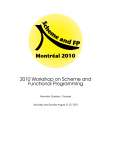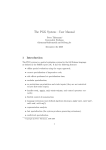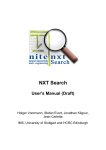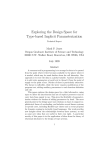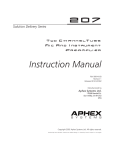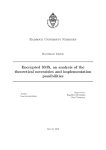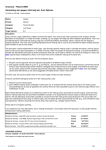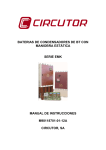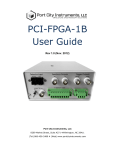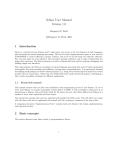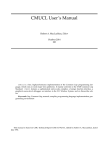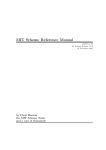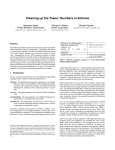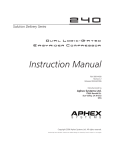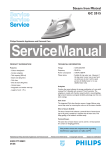Download A Sufficiently Smart Compiler for Procedural
Transcript
A Sufficiently Smart Compiler for Procedural Records
Andrew W. Keep
R. Kent Dybvig
Cisco Systems, Inc. and Indiana University
{akeep,dyb}@cisco.com
Abstract
Many languages include a syntax for declaring programmerdefined structured data types, i.e., structs or records. R6RS supports syntactic record definitions but also allows records to be defined procedurally, i.e., via a set of run-time operations. Indeed,
the procedural interface is considered to be the primitive interface,
and the syntactic interface is designed to be macro expandable into
code that uses the procedural interface. Run-time creation of record
types has a potentially significant impact. In particular, record creation, field access, and field mutation cannot generally be open
coded, as it can be with syntactically specified records. Often, however, the shape of a record type can be determined statically, and in
such a case, performance equivalent to that of syntactically specified record types can be attained. This paper describes an efficient
run-time implementation of procedural record types, discusses its
overhead, and describes a set of compiler optimizations that eliminate the overhead when record-type information can be determined
statically. The optimizations improve the performance of a set of
representative benchmark programs by over 20% on average.
1.
Introduction
The record system for the Revised6 Report on the Algorithmic Language Scheme (R6RS) [16] differs from more traditional methods
of defining structured data types, such as structs in C, in that record
types, record predicates, record constructors, field accessors, and
field mutators are created dynamically, i.e., at run time.
A program creates a record type by creating a record-type descriptor (RTD) that describes the type. When creating an RTD, the program can specify a parent RTD, in which case the resulting record
type is an extension of the parent record type via single inheritance.
The program must specify the fields that each instance of the type
should have, in addition to those of its parent type, if any, and
whether each is mutable. It must also specify whether the record
type is sealed and whether the record type is opaque. A sealed
record type cannot be used as the parent type for another record
type, i.e., it cannot be extended. If a record type is opaque, instances of the type cannot be inspected (Section 2.2). The program
can also supply a UID, in which case the record type is considered
nongenerative rather than generative. Any subsequent attempt to
c 2012 Andrew W. Keep and R. Kent Dybvig
Copyright create a record type with the same UID produces the same record
type, except that if the parent, fields, sealedness, or opaqueness are
not the same, the attempt causes an exception to be raised. Each
record type is distinct from all built-in types and from other record
types, although an instance of a record type is considered an instance of its parent type, if any.
Once an RTD has been created, the program can use it to create a
record predicate, which returns true only for instances of the record
type, along with accessors and mutators that can be used to extract
values from or store values into the fields of an instance of the
record type. It can also create a record constructor for the record
type, but it must first create a record-constructor descriptor (RCD).
An RCD controls how direct instances of the record type are created and partially controls how instances of its child types are created. When creating an RCD, a program specifies a parent RCD,
if the record type has a parent type, and a protocol. The protocol
determines the arguments expected by the record constructor, how
the fields of a new instance are initialized from the arguments, and
possibly actions to be taken on the instance before it is returned
from the constructor.
The RTD, RCDs, constructors, predicate, accessors, and mutators
for a record type can be created either via a set of run-time procedures that comprise a procedural interface or via a syntactic interface. Uses of the syntactic interface can always be expanded into
uses of the procedural interface, which is the simplest way to implement the syntactic interface.
While the syntactic interface is often more convenient, the procedural interface is more flexible. For example, it allows the construction of portable interpreters that allow the programs they interpret
to construct host-compatible record types. It also allows the creation of arbitrary new data types at run time, e.g., based on data
read from an input file. When coupled with the inspection interface
(Section 2.2), which includes a procedure to extract the RTD from
a record instance, it allows the construction of portable debuggers
and pretty-printers for records.
The flexibility of the procedural interface and the simplicity of
implementing the syntactic interface via the procedural interface
comes at a price. Because RTDs, RCDs, constructors, predicates,
accessors, and mutators are all created at run time, record creation,
access, and mutation are out-of-line operations requiring indirect
jumps and possible pipeline stalls, possibly along with memory
overhead beyond that which would be necessary in a straightforward implementation of a syntactic interface, e.g., to extract the
RTD (for type checking) and field index from the closure of an accessor or mutator. In addition, record-definition code must be put at
the top level of a program or library if creation of the RTDs, RCDs,
constructors, predicates, accessors, and mutators is to happen only
at initialization time—an unfortunate constraint and not an obvious
one when the syntactic interface is used.
This paper describes an efficient implementation of the procedural
interface and a set of compiler optimizations that eliminate its
inherent overhead when sufficient information about a record type
can be determined statically. In particular:
• RTDs for nongenerative record types are created at compile
time, and RCDs are dropped entirely.
• Allocation is performed inline except when there are multiple
constructor call sites and the code is too large to replicate.
• Record-predicate calls reduce to an inline record-type check.
• A record field reference or mutation reduces to an inline record-
type check and a single memory operation, or just a single
memory operation when the type of a record instance can be
determined at compile time.
In addition, operations on nongenerative record types with immutable fields occur at compile time whenever possible, i.e., whenever the arguments to a constructor can be determined at compile
time, and whenever a field accessor is applied to a constant record
instance.
Sufficient information can always be determined statically when a
record type is defined exclusively via the syntactic interface. Thus,
the optimizations above always apply to the syntactic interface.
Furthermore, it is rarely necessary to place a syntactic definition for
a nongenerative record type at top level, since it does not involve
any run-time overhead beyond evaluating the programmer-supplied
protocol expression, if any.
The optimizations improve the running time of a set of benchmarks
by an average of over 20% versus the base procedural interface
and a few percent over an implementation of records simulated
by vectors. For some programs, the optimizations are substantially
more effective; for example, they improve the speed of the Chez
Scheme compiler, which makes extensive use of records, by nearly
90%.
The rest of this paper is organized as follows. Section 2 describes
the R6RS procedural, syntactic, and inspection interfaces. Section 3
describes the implementation of the procedural interface. Section 4
describes the compiler optimizations. Section 5 describes a set of
benchmarks and compares how they run with the optimizations
enabled or disabled. Section 6 discusses related work. Finally,
Section 7 discusses future work and concludes.
2.
The R6RS Record System
This section presents an overview of the procedural, syntactic, and
inspection interfaces to the R6RS record system and can be skipped
by readers who are already familiar with the record system.
We start by looking at how to create a simple point record type
that contains x and y fields, using the procedural interface.
(define point-rtd
(make-record-type-descriptor ’point #f #f
#f #f ’#((mutable x) (mutable y))))
(define point-rcd
(make-record-constructor-descriptor
point-rtd #f #f))
(define make-point (record-constructor point-rcd))
(define point? (record-predicate point-rtd))
(define point-x (record-accessor point-rtd 0))
(define point-x-set! (record-mutator point-rtd 0))
(define point-y (record-accessor point-rtd 1))
(define point-y-set! (record-mutator point-rtd 1))
The point record-type descriptor (RTD) specified here does not
inherit from any other RTD. It is generative, so a new (and unique)
RTD is created each time the make-record-type-descriptor
call is evaluated. In particular, if the code appears in a loop, a new
RTD is constructed on each iteration of the loop. The RTD is not
sealed, meaning it can be a parent RTD to other record types. The
RTD is not opaque, meaning the RTD can be inspected. Finally, the
RTD specifies two mutable fields x and y.
Creating the constructor for the point record type requires a
record-constructor descriptor (RCD). The RCD specified here is
the default RCD. The default RCD specifies that there is no parent
RCD and no protocol. It creates a constructor procedure that expects one argument for each field in the record and initializes each
field to the value of the corresponding argument. The constructor
for the point record type is generated with the RCD. The predicate, accessors, and mutators for point record type are generated
with the RTD and, in the case of the accessors and mutators, the
index of the field.
Most record types, including the point record type, can be created
using the more convenient syntactic interface:
(define-record-type point
(fields (mutable x) (mutable y)))
The define-record-type form can be implemented as a macro,
and this occurrence might expand into the procedural-interface
code shown above. The only difference, in this case, is that the
point-rtd and point-rcd variables are not made visible via the
syntactic interface, though the RTD and RCD are still created.
(The syntactic interface does provide forms for looking up the
RTD and RCD from a record name.) In addition to the fields
clause, define-record-type can specify its generativity with
the nongenerative clause, whether it is sealed with the sealed
clause, whether it is opaque with the opaque clause, a parent
record type with the parent or parent-rtd clauses, and a record
protocol with the protocol clause.
2.1
Protocols and inheritance
Record inheritance in the R6RS record system is designed to allow
child record types to be created and used without specific knowledge of parent fields. This is why field indices for a child record
type begin at zero even when the parent record type has one or
more fields. It is also why protocols exist. Protocols provide an
expressive way to abstract record creation, but this ability could
be simulated by embedding the creation procedure within another
procedure. More importantly, they free code that allocates a child
record type from needing to know about the parent’s fields, how
to initialize them, and other actions required when an instance of
the parent record type is created. The code needs to know only
the arguments expected by the parent protocol. This is especially
convenient when a parent record type is modified during program
development, since code that deals with child record types need not
change as long as the parent protocol remains the same.
A protocol is analogous to a constructor or init method in objectoriented programming and serves a similar purpose, with an appropriately more functional style. One use for a record protocol is
to specify default values for fields that do not need to be specified
when an instance of the record is created. Protocols are not limited
to this, though, and can be used, e.g., to check for valid constructor
arguments, register records with some global database, or mutate
the record being constructed to create cycles.
For instance, imagine we want to create a record that stores a color
name and the red, green, and blue (RGB) values for the color. We
could create a record like the following:
(define-record-type color (fields name r g b))
The color record type is generative, is not sealed, is not opaque,
and has four immutable fields: name, r, g, and b. In our representation, we always want name to be a symbol and r, g, and b to
be integer numbers between 0 and 255. This restriction could be
enforced through a protocol as follows:
representation as well as the RGB values. We can derive a new
web-color record type from color to accomplish this.
(define-record-type web-color
(parent color)
(fields hex-color)
(nongenerative)
(protocol
(lambda (pargs->new)
(lambda (name r g b hex-color)
(let ((new (pargs->new name r g b)))
(new hex-color))))))
(define-record-type color
(fields name r g b)
(protocol
(lambda (new)
(lambda (name r g b)
(unless (symbol? name)
(error ’make-color
"name must be a symbol" name))
(unless (and (fixnum? r) (<= 0 r 255)
(fixnum? g) (<= 0 g 255)
(fixnum? b) (<= 0 b 255))
(error ’make-color
"RGB value outside range" r))
(new name r g b)))))
The web-color record type indicates that it inherits from color
by naming color in the parent clause. It also provides a protocol.
The first difference evident in the web-color protocol is that
instead of being passed a procedure that takes all of the fields
for the parent and the child record, it receives a procedure in the
pargs->new formal that expects the parent arguments and returns
a procedure that expects the child field values (in this case, just the
value of hex-color). When a new web-color is created it should
be added to the global *colors* list, just as a new color record
is added. Fortunately, the protocol for color is invoked as part of
the process of creating the new web-color so there is no need for
the web-color protocol to duplicate this effort.
The protocol keyword specifies that this object has a protocol
expression. Because the color record type does not inherit from
any other record types, its protocol is passed a procedure to build
the record that accepts one argument for each field in color. In
this case, the protocol expression returns a procedure with one
argument for each field in the color record type. This procedure
performs the checks and then creates a new color record instance.
The color protocol checks the arguments and adds the record
to the *colors* list, but we might not want the user of the
web-color record type to need to supply the color twice, once as a
web color and once as a set of RGB values. In fact, this could lead
to inconsistencies, since the web color string and the RGB value
might specify different colors. One option is to use a protocol to
check that these are consistent, but a better option would be to perform the conversion. Again, we can use a protocol to do the work,
with an appropriately defined rgb->hex-color (not shown):
Another feature we might like is to store each color record in a
global list of colors. If the record definition for color is at the toplevel of a library or program, this will work without any changes.
However, since the record type is generative, if it was moved into
a context where it could be executed more then once, it might lead
to the global list containing instances of many color record types
with the same shape, but different RTDs. To avoid this we mark
color nongenerative.
(define *colors* ’())
(define-record-type color
(nongenerative)
(fields name r g b)
(protocol
(lambda (new)
(lambda (name r g b)
(unless (symbol? name)
(error ’make-color
"name must be a symbol" name))
(unless (and (fixnum? r) (<= 0 r 255)
(fixnum? g) (<= 0 g 255)
(fixnum? b) (<= 0 b 255))
(error ’make-color
"RGB value outside range" r))
(let ((c (new name r g b)))
(set! *colors* (cons c *colors*))
c)))))
With this definition of the color record type, each new color
is recorded in a global list of colors. Specifying colors by RGB
value is convenient, but if we are working on a web project, we
might want to create colors that store the HTML hexadecimal
(define-record-type web-color
(parent color)
(fields hex-color)
(nongenerative)
(protocol
(lambda (pargs->new)
(lambda (name r g b)
((pargs->new name r g b)
(rgb->hex-color r g b))))))
The protocol specified above converts from an RGB representation
to a hexadecimal string representation used by web pages to indicate colors. This value is then filled in for the hex-color field of
the web-color record type.
Now that we have a set of record types defined, we define some
color records, find the color named red in the color list, and extract
its hex-color value:
(make-web-color ’red 255 0 0)
(make-web-color ’green 0 255 0)
(make-web-color ’blue 0 0 255)
(define red
(find
(lambda (c) (eq? (color-name c) ’red))
*colors*))
(web-color-hex-color red)
⇒
"#FF0000"
The protocol for the web-color record types calculates the HTML
hexadecimal color from the red, green, and blue arguments. The
protocol for the color record type checks the name is a symbol
and that the red, green, and blue values are within the appropriate
range.
2.2
The inspection interface
It is also possible to determine information about the type of a
record instance using the inspection interface, as the following
example demonstrates.
(define red-rtd (record-rtd red))
(record-type-descriptor? red-rtd)
(record-type-name red-rtd)
(record-type-generative? red-rtd)
(record-type-uid red-rtd)
(record-type-sealed? red-rtd)
(record-type-opaque? red-rtd)
(record-field-mutable? red-rtd)
(record-type-field-names red-rtd)
(define p-rtd
(record-type-parent red-rtd))
(record-type-name p-rtd)
⇒
⇒
⇒
⇒
⇒
⇒
⇒
⇒
#t
web-color
#f
web-color
#f
#f
#f
#(hex-color)
⇒
color
These operations allow a program (e.g., a portable debugger) to
retrieve information about the record type, and when combined
with the procedural interface for creating record accessors and
mutators, also allow the program to retrieve or even modify the
contents of the record instance. If the record type of a record
instance is opaque, the record-rtd procedure raises an exception,
effectively preventing inspection of the record and its type.
3.
Implementation
Although we hope that most uses of the procedural record system
can be optimized into efficient compiled code, it is still important to
have an efficient implementation of the procedural interface. There
will always be cases where the shape of a record type cannot be determined at compile time, and the compiler optimizations cannot be
applied, as when record types are generated based on information
available only at run time. An efficient implementation of the procedural interface also gives us a competent base against which to
measure the benefits of our optimizations when the optimizations
can be applied.
The implementation precalculates record sizes and field offsets to
avoid repeating these calculations each time a record instance is
created or a field is accessed or mutated. It also special-cases the
creation of record constructors with just a few arguments to avoid
the use of “rest” argument lists and apply.
The first step in creating a record type is to create the record-type
descriptor (RTD). The make-record-type-descriptor procedure begins by checking that the newly specified record type is
valid. If the record type is nongenerative, this includes checking
to see if the RTD already exists. If the RTD exists, the arguments
are checked to ensure the RTD matches those specified. If the RTD
does not exist or the record type is generative a new RTD must be
created. If a parent RTD is specified, the inheritance hierarchy is
traversed to gather the full field list for the new record type. Once
the full field list is known, the total size of the record type and the
byte offset for each field is calculated. Information about each field
is stored in a vector with the field name, a flag to indicate if the
field is mutable, and the byte-offset of the field1 . The fields list,
1 Chez
Scheme allows a native type, such as integer-8 or double to be
specified for a field type, and this information is also stored in the field list,
though for R6RS records, the type is always Scheme object.
along with the parent RTD, record type name, record type UID,
sealed flag, and opaque flag are all stored in the RTD. Our implementation uses a record to represent the RTD. The RTD’s own RTD
is also a record, with a base RTD ultimately terminating the chain.
The make-record-constructor-descriptor procedure is used
to create a record-constructor descriptor (RCD) from an RTD. It
first checks that it is given a valid RTD. When a parent RCD is
specified, it also checks that it is an RCD for the parent RTD, and
that a protocol procedure is also specified. The RCD is represented
by a record and contains the RTD, parent RCD, and protocol.
Generating the record constructor procedure is one of the more
complicated parts of implementing the record system. The combination of protocols and inheritance means that the constructor must
first gather up the values for all of the fields by calling each protocol
procedure in the hierarchy in turn, then construct the new record instance, and finally return the record instance through each protocol
procedure. The implementation for this is shown in Figure 1.
First, a procedure for constructing the final record instance is defined as rc. If the number of fields is small (six or fewer), it creates
this procedure with an exact number of arguments and then calls
the internal record constructor $record with the RTD and the values of the fields. If the number is larger then six, it defaults to using
a rest argument and then calls $record with apply. This procedure also checks to make sure the correct number of arguments are
received. If the RCD does not specify a protocol, rc is the constructor. Otherwise, the protocol procedure must be called. If no parent
RTD is specified, the rc is passed to the protocol as the procedure
to construct the final record. If a parent RTD is specified, the procedure must traverse each level of the inheritance hierarchy until it
reaches the base of the inheritance or finds a parent that does not
specify a protocol. At each stage of this recursion the parent protocol is called on a constructed procedure until values for all the
fields in the record type are gathered and the record instance can
be constructed. The internal record creation primitive $record is
responsible for allocating and filling the fields.
The record-accessor procedure takes an RTD and an index into
the field vector constructed by make-record-type-descriptor.
It uses the find-fld helper to find the field offset as shown in
Figure 2. It then constructs the accessor procedure using the field
RTD to check that the argument to the accessor is a valid record
instance and the precalculated field offset to reference the field.
The type check uses an extended version of record? that takes
an RTD as a second argument. The find-fld helper checks that
the first argument to record-accessor is an RTD and that the
index is a non-negative fixnum. The list of fields is then retrieved
from the RTD, and if there is a parent RTD, the index is adjusted
to select the correct field from the child fields. The field offset is
precalculated by make-record-type-descriptor so it is simply
retrieved from the field descriptor in the RTD with the fld-byte
accessor. The accessor procedure returned has the RTD and the
offset in its closure, so it does not need to calculate it when it is
called.
The record-mutator procedure requires much the same information as the record-accessor procedure. It uses the find-fld
helper to find the field, but must perform an additional check to
ensure the field is mutable before returning the mutator procedure.
It also replaces the mem-ref operation of the record-accessor
with a mem-set!. The implementation of this is in Figure 3.
The record-predicate procedure uses the RTD to determine
if it should call the built-in $sealed-record? predicate or the
record? predicate for the RTD. Its implementation is shown in
Figure 4. The $sealed-record? predicate is potentially faster,
(define record-constructor
(lambda (rcd)
(unless (rcd? rcd) (error ’record-constructor "not a record constructor descriptor" rcd))
(let ((rtd (rcd-rtd rcd)) (protocol (rcd-protocol rcd)) (flds (rtd-flds rtd)))
(let ((nflds (length flds)))
(define rc
(case nflds
((0) (lambda () ($record rtd)))
((1) (lambda (t0) ($record rtd t0)))
((2) (lambda (t0 t1) ($record rtd t0 t1)))
((3) (lambda (t0 t1 t2) ($record rtd t0 t1 t2)))
((4) (lambda (t0 t1 t2 t3) ($record rtd t0 t1 t2 t3)))
((5) (lambda (t0 t1 t2 t3 t4) ($record rtd t0 t1 t2 t3 t4)))
((6) (lambda (t0 t1 t2 t3 t4 t5) ($record rtd t0 t1 t2 t3 t4 t5)))
(else (lambda xr
(unless (fx=? (length xr) nflds) (error #f "incorrect number of arguments" rc))
(apply $record rtd xr)))))
(if protocol
(protocol
(cond
((rtd-parent rtd) =>
(lambda (prtd)
(lambda pp-args
(lambda vals
(let f ((prcd (rcd-prcd rcd)) (prtd prtd) (pp-args pp-args) (vals vals))
(apply
(cond
((and prcd (rcd-protocol prcd)) =>
(lambda (protocol)
(protocol
(cond
((rtd-parent prtd) =>
(lambda (prtd)
(lambda pp-args
(lambda new-vals
(f (rcd-prcd prcd) prtd pp-args (append new-vals vals))))))
(else (lambda new-vals (apply rc (append new-vals vals))))))))
(else (lambda new-vals (apply rc (append new-vals vals)))))
pp-args))))))
(else rc)))
rc)))))
Figure 1. The record-constructor procedure
since it can perform a simple eq? check between the RTD in the
record instance and the RTD supplied. The record? predicate
must take into account the possibility of inheritance. The record
predicate returned has only the RTD in its closure.
This implementation, however, is about as efficient as we can make
it without compiler optimizations such as those described in the
following section. Record accessors and mutators use precalculated
indices. Constructors for smaller records are special-cased to avoid
some rest-list and apply overhead.
Yet, many sources of overhead remain. A constructor, predicates,
accessor, or mutator created returned by the procedural interface
must be called via an anonymous call involving extraction of a code
pointer from the procedure and an indirect jump that together result in additional memory traffic and a potential pipeline stall. A
record predicate, accessor, or mutator must also extract the RTD
and (for an accessor or mutator only) the field index from its closure, resulting in additional memory traffic. Record construction
with default protocols similarly requires an indirect procedure call
to the constructor procedure and a memory reference to retrieve the
RTD. A constructor with programmer-supplied protocols additionally requires indirect calls to each of the protocols involved. It also
requires nested procedures and rest lists to be created for each level
of inheritance and additional allocation to combine the arguments
into a single list to which rc is eventually applied.
The implementation could special case constructors for records
with even more fields, and it could also special-case accessors and
mutators with small field indices to avoid retrieving the computed
index from the closure, but these changes are not likely to have
much impact.
4.
Compiler optimizations
It is often the case that the shape of the instances of a record
type can be determined at compile time. In such cases, we would
like to avoid as much of the procedural interface overhead as possible. In particular, record-type descriptors (RTDs) and recordconstructor descriptors (RCDs) for nongenerative types should be
created at compile time whenever possible, i.e., when all of the
arguments to the RTD and RCD creation procedures reduce to constants. Second, record allocation should be done inline, as it is with
the vector primitive. Third, access and mutation of record fields
should be performed inline, as when constant indices are supplied
to vector-ref and vector-set!. Finally, creation of record instances for nongenerative record types with only immutable fields
should happen at compile time when the arguments to the construc-
tor are constant, and references to a field of a constant record instance should be folded into the value of the field.
(define find-fld
(lambda (who rtd idx)
(unless (record-type-descriptor? rtd)
(error who "not a record type descriptor"
rtd))
(cond
((and (fixnum? idx) (fx>=? idx 0))
(let ((flds (rtd-flds rtd))
(prtd (rtd-parent rtd)))
(let ((real-idx
(if prtd
(fx+ (length (rtd-flds prtd))
idx)
idx)))
(when (fx>=? real-idx (length flds))
(error who
"invalid field index for type"
idx rtd))
(list-ref flds real-idx))))
(else (error who "invalid field specifier"
idx)))))
(define record-accessor
(lambda (rtd idx)
(let ((offset (fld-byte (find-fld
’record-accessor
rtd idx))))
(lambda (x)
(unless (record? x rtd)
(error #f "incorrect type" x rtd))
(mem-ref x offset)))))
Figure 2. The record-accessor procedure and the find-fld
helper
One approach would be to focus on the syntactic interface. The
shape of a record type created exclusively with the syntactic interface2 is always known at compile time. Programmers coming
from languages that provide only a syntactic interface for creating
records might also expect that these operations be generated statically.
This approach would likely handle well a majority of R6RS programs, but it would fail to serve programs that use the procedural
interface directly, and it would not serve programmer-defined syntactic interfaces unless those are specified directly in terms of the
procedural interface.
A better approach is to expand the syntactic interface into the
procedural interface and use compiler optimizations to recover
static record performance, taking care that the optimizations handle
the expansion of the syntactic interface at least as well as direct
optimization of the syntactic interface. In this way, we handle well
most programs that use either interface.
With our approach, the code for record constructors, accessors,
and mutators is generated at compile time when the shape of a
record type can be determined. This is always the case for the
expanded output of the syntactic interface and might often be the
case when the procedural interface is used directly. Furthermore,
constructors for nongenerative record types with only immutable
fields and arguments whose values can be determined at compile
time are identified and folded. Accessors for immutable fields are
also folded when their arguments can be determined at compile
time. Finally, RTDs and RCDs for nongenerative record types are
created at compile time whenever the values of all of their fields
can be determined at compile time.
4.1
(define record-mutator
(lambda (rtd idx)
(let ((fld (find-fld ’record-mutator
rtd idx)))
(unless (fld-mutable? fld)
(error ’record-mutator
"field is immutable" idx rtd))
(let ((offset (fld-byte fld)))
(lambda (x v)
(unless (record? x rtd)
(error #f "incorrect type" x rtd))
(mem-set! x offset v))))))
Figure 3. The record-mutator procedure
(define record-predicate
(lambda (rtd)
(unless (record-type-descriptor? rtd)
(error ’record-predicate
"not a record type descriptor" rtd))
(if (record-type-sealed? rtd)
(lambda (x) ($sealed-record? x rtd))
(lambda (x) (record? x rtd)))))
Figure 4. The record-predicate procedure
Leveraging the source-level optimizer
The source-level optimizer in Chez Scheme [7] provides copy propagation, constant propagation, constant folding, and aggressive procedure inlining. The optimizer uses effort and size counters to ensure the pass runs in linear time and does not excessively expand
the code. Constant folding for simple primitives is handled by calling the built-in primitives at compile time, based on a table of
primitives that indicates when this is possible. For instance, the
vector-ref primitive can be folded when the first argument is
a constant vector, the second argument is a fixnum, and performing
the operation does not raise an exception. More complicated primitives, i.e., those that require additional checks on their arguments,
generate λ-expressions, or can only be optimized in some specific
cases, are handled by a set of primitive handlers.
The optimizer works by maintaining an environment mapping
known variables to one of three compile-time values. When a variable maps to another variable, copy propagation occurs. When a
variable maps to a constant, constant propagation occurs. When a
variable maps to a λ-expression, and the variable is referenced in
call position, an inlining attempt is made. Inlining will not succeed
if the effort or size counters exceed their specified bound during
the inlining attempt, except that inlining always succeeds in cases
where the reference is the only reference to the variable.
2 That
is, defined using define-record-type with a parent, if any, specified using the parent form and defined exclusively with the syntactic interface
4.2
Extending the source-level optimizer
We use the ability to define primitive handlers to perform compiletime optimization of the procedural interface. We also extend
the optimizer’s set of compile-time values to include partially
static [15] representations of RTDs and RCDs when they cannot be
reduced to constants, thus allowing the optimization of generative
record types and of nongenerative record types for which certain
pieces of information, such as opaqueness, cannot be determined at
compile time. The remainder of this section describes the primitive
handlers for each of the primitives that comprise the procedural
interface. We start with make-record-type-descriptor since it
is the starting point for run-time record-type creation.
The make-record-type-descriptor primitive handler can create the RTD at compile time when all of the arguments to the procedure are known and the record type is nongenerative. This fits
well with the source inliner, but it does not allow us to optimize
generative record types, since the RTD for a generative record type
must be created each time the specification for the record is encountered. Even when the final RTD is not known, however, it is
still possible to generate constructor, predicate, accessor, and mutator λ-expressions for the record type when the shape of the record
is known at compile time.
The only two pieces of information needed to determine the shape
of the RTD are the parent RTD and the number of fields specified in
this record type. With these two pieces of information, it is possible
to determine how much space must be allocated when creating a
new record instance and the byte offsets of each field in the record
at compile time3 . In particular, information about the name of the
record type, whether it is opaque, and whether it is sealed is not
needed.
In such cases, the handler produces a partially static representation
of the RTD. The partially static representation has two parts: a
compile-time RTD and an expression that will evaluate, at run time,
to the run-time RTD. The compile-time RTD is a version of the runtime RTD containing the (possibly partially static) parent RTD, if
any, the field information, and any other information that happens
to be available. All other information is marked unspecified.
When a fully or partially static RTD cannot be created, e.g., because
the set of fields cannot be determined, the call is left unoptimized.
The value of make-record-type-descriptor is typically bound
to a variable, at least after inlining of helpers that might otherwise
obscure the binding. When the handler produces a constant or
partially static RTD, the optimizer’s environment maps the variable
to the RTD where it can be propagated to its reference sites and
thus made available to the handlers for the other record primitives.
The make-record-constructor-descriptor primitive handler
can create an RCD at compile time when the RTD is known (and
not partially static), the parent RCD is omitted or known (and not
partially static), and the protocol is omitted or known (i.e., its value
is determined to be a quoted procedure). Otherwise, it can create
a partially static RCD when the (possibly partially static) RTD
is known, the (possibly partially static) parent RCD is known or
omitted, and the protocol is either omitted, a known procedure, or
an unassigned variable bound to a λ-expression. If the protocol is
a λ-expression, a temporary is bound to the λ-expression and the
temporary is used as the protocol. (This prevents unwanted code
duplication in cases where the RCD is used in multiple places.)
The partially static RCD contains a compile-time representation of
3 The types
of the fields must also be known when Chez Scheme’s extended
record interface is used.
the RCD and the expression to generate the RCD at run time. The
compile-time RCD contains a (possibly partially static) RTD, the
(possibly partially static) parent RCD, and the protocol expression.
The primitive handler for record-constructor can generate a
λ-expression for the constructor whenever the (possibly partially
static) RCD is known. Generation of the λ-expression is complicated by the presence of inheritance and record protocols, reflecting the run-time complexity of the record-constructor procedure (Figure 1). It is worthwhile to do so, since the source optimizer can help compact the code, even eliminating the generated
apply and rest arguments to the nested λ-expressions in most cases.
For instance, consider the web-color record type from Section 2.
It specifies a protocol expression and inherits from the color
record type, which also specifies a protocol. The constructor for
web-color must call both of these protocols to gather up the field
values of the new record instance, and must return the record instance through each protocol. The generated code is as follows.
(web-color-protocol
(lambda parent-args
(lambda (hex-color)
(apply
(color-protocol
(lambda (name r g b)
($record web-color-rtd
name r g b hex-color)))
parent-args))))
The call to $record is generated for every record constructor and
is ultimately responsible for allocating the record instance and filling it with the RTD and field values. The outermost λ-expression
is generated to supply the pargs->new procedure expected by the
web-color protocol. The procedure returned by the outermost λexpression expects the value for the hex-color field. This procedure then applies the parent-args supplied when the web-color
protocol called pargs->new, so that these arguments can be passed
on to the color protocol. The color protocol is then passed a procedure that expects the name, r, g, and b field values and constructs
a record instance. The record instance is returned to the color protocol’s call of new. The color protocol adds the new record to the
*colors* database. From here it is returned through the generated λ-expression to the web-color protocol. Thus each protocol
is called in turn to supply the field values that make up the record
instance and the record instance is returned through the protocols.
With the constructor code generated, the inliner can now optimize
the code. It takes advantage of the fact that the parent-args rest
argument that is passed on to the apply is known to be a constant
list of a given length to enable further optimization. Without this
information, the inliner would not be able to eliminate the call to
apply.
The optimized output for the constructor looks like the following4 :
(define make-web-color
(lambda (name r g b)
(let ((str (rgb->hex-color r g b)))
(unless (symbol? name)
(error ’make-color
"name must be a symbol" name))
(unless (and (fixnum? r) (<= 0 r 255)
(fixnum? g) (<= 0 g 255)
4 Ideally,
rgb->hex-color would be called only after the r, g, and b
values have been checked, but R6RS does not specify when field values are
computed, so it is not something a programmer can depend upon regardless
of our implementation.
(fixnum? b) (<= 0 b 255))
(error ’make-color
"RGB value outside range" r))
(let ((c ($record web-color-rtd
name r g b str)))
(set! *colors* (cons c *colors*))
c))))
The optimized, generated constructor expression incorporates both
protocols and completely eliminates the nested λ-expressions, rest
arguments, and calls to apply. Furthermore, the generated λexpression can be inlined at constructor call sites, allowing inline
allocation and potentially further simplification, although in this
particular example the inliner is unlikely to do this unless some of
the arguments are constant, so that the code size is reduced, or there
is only one call site.
The record-predicate handler always generates a λ-expression
that calls the extended record? predicate, similarly to the implementation of the record-predicate procedure in Section 3. Generating the λ-expression in the optimizer allows it to be inlined at
its call sites or called directly, unlike with the base procedural implementation.
The record-accessor handler generates a λ-expression containing a record check expressed using the extended record? predicate
and the access operation expressed using a low-level mem-ref operator. For instance, the record accessor for the hex-color field of
the web-color record is generated as follows5 .
(define web-color-hex-color
(lambda (x)
(unless (record? x web-color-rtd)
(assertion-violationf ’moi
" ˜ s is not of type ˜ s"
x web-color-rtd))
(mem-ref x 21)))
Because the byte offset of the field is computed at compile time,
the constant offset is directly included in the mem-ref call. When
the RTD is constant, the second argument to record? is the quoted
RTD.
Generating the λ-expression at compile time allows it to be inlined
at its call sites. When an object at the call site is known to be of
the correct type, for instance when a type recovery analysis has
determined it to be of the correct type, the record type check can
also be eliminated and the residual code at the call site is simply a
memory reference.
The record-mutator handler is similar to the record-accessor
handler, with the generated λ-expression taking an additional argument representing the new value and calling mem-set! rather than
mem-ref. It leaves the code unoptimized if the field is not mutable
so that an appropriate exception is raised at run time.
4.3
Optimizing immutable record creation
When the λ-expression for a constructor is inlined at a call site,
it is possible that the record instance built there can be created at
compile time. This is possible when a constructor can be folded
5 The assertion-violationf procedure is a Chez Scheme extension that
allows for formatted error messages. The ’moi expression is used by the
compiler to choose the who argument based on the name of the containing
procedure, when that can be determined.
down into a call to $record6 under the following conditions: (1)
the RTD must reduce to a constant and must indicate that the
record is nongenerative and that all of the fields (including those
of any parent record type) are immutable, and (2) the arguments to
$record that represent the field values must reduce to constants.
This is an optimization that cannot be performed on vectors or
pairs, without further analysis, since their contents are always mutable.
When a constant record is available at compile time, either because
it was present in the source, inserted by a macro, or produced
by a folded constructor call, calls to record predicates and record
accessors are also evaluated at compile time. A predicate call is
optimized into a true or false value, depending on the result of
the predicate. An accessor call is optimized into the constant value
stored in the accessed field.
4.4
Handling the top-level
A record-type definition that appears at the top-level of an R6RS
library or program is guaranteed to be encountered only once.
Because of this, a generative record type is indistinguishable from a
nongenerative record type. The source inliner can make use of this
observation to treat generative record types as nongenerative when
they appear at the top-level of an R6RS program or library.
Chez Scheme also supports an interactive top-level, and the optimization of generative to nongenerative types also applies to it.
Variables in the interactive top-level are always mutable, however,
so the values of the variables bound to the RTD and RCD cannot be propagated to their reference sites in the code that creates
the other record-definition products. Instead, the syntactic interface
constructs the RTD and, when possible, the RCD, during macro expansion and uses identifier macros to place the constants directly at
the reference sites.
5.
Analysis
The optimizations presented in the preceding section recover the
performance of static record types and improve on them when
record instances can be constructed at compile time. To get an idea
of how important this is to program performance, we tested a small
number of benchmarks that make use of record types.
The benchmarks are taken from the R6RS benchmarks [4], the
Computer Language Benchmarks Game [9], and some benchmarks
used to test performance in Chez Scheme in the past.
The benchmarks from the Computer Language Benchmarks Game
and the GC benchmark from the R6RS benchmarks all make use of
record types. The other benchmarks were converted to use record
types in place of vector-based records.
In addition to the benchmarks, we measured the Chez Scheme compiler compiling itself with and without the compiler optimizations
described in Section 4, to demonstrate their impact on a larger program that makes extensive use of records.
The benchmarks were run on a 2.8 GHz Intel Core i7-930 CPU
with 12 GB of RAM running the Fedora 13 Linux distribution.
The 32-bit version of Chez Scheme was used for benchmarking.
Each benchmark was run six times and CPU time for each run was
6 It
is not always possible to fold a constructor call into a call to $record
since some expressions, such as the set! in the color protocol, cannot be
folded at compile time.
100%
place of protocols provides a number of options for configuring
constructors with default field values and field type checks. These
systems do not implement the compiler optimizations described in
Section 4.
80%
Scheme 48 [14], Chicken [18], and probably many other Scheme
implementations provide a set of low-level operators for constructing a record instance from an RTD and the values of the fields,
checking a record instance type, and referencing and setting record
fields using an integer index to indicate the field position. Scheme
48 and Chicken (via user-committed libraries, or Eggs) support
both higher level procedural and syntactic interfaces built using the
low-level operators. These systems do not implement the compiler
optimizations described in Section 4.
60%
40%
20%
0%
e
rs
y
ve
la
tra
sp
ns
er
ex
oy
at
sl
sb
y
ra
c
ffi
ei
ra
cl
pa
nu
y
er
oy
nb
e
h
p
nc
od
az
nb
m
be
r
l
la
gc
n
-im
em
y
-fu
r
m
or
rle
em
ea
le
pi
nf
m
co
co
e
m
es
he
tre
Sc
ry
z
na
bi
he
C
Figure 5. Percent of run-time improvement
averaged to get the time for each benchmark. On average, we saw a
21.2% improvement in run-time performance for the benchmarks,
with improvements ranging from 0% to 54.4%. The percentage
of improvement for each benchmark is shown in Figure 5 along
with the improvement in the Chez Scheme compiler, which is a
notable 89.5%. The binarytrees and nbody benchmarks come from
The Computer Languages Benchmarks Game. The em-fun and emimp benchmarks were originally written by Jefferey Mark Siskind
and implement an EM clustering algorithm. The lalr benchmark
performs LALR parsing. The splay benchmark is originally from
CF Analysis Development and implements a splay tree benchmark.
The traverse benchmark is an R6RS version of Richard Gabriel’s
original traverse benchmark.
We also compared the results with the vector-based versions of the
benchmarks. On average, the tests were 27% slower using records
with the base procedural implementation, ranging from 2.5% faster
to 107% slower. On average, the tests were 4.3% faster using
records with the compiler optimizations described in Section 4 enabled, ranging from 38.0% faster to 10% slower. In the cases where
the vector implementation is slower than the record implementation, it is likely because the vector implementation contains an extra field to store the type of the vector, and checking to make sure it
is of the correct type is often done using a combination of a vector
type check, a length check, and a check of the tag, before performing the vector reference or set operation, which performs a second
vector type check and range check.
Compile-time overhead for the handlers that expand calls to the
record primitives into code that can be further optimized by the
inliner is negligible. The code produced by the handlers gives
the inliner more work to do, but the final code generated by the
inliner typically contains less code, which reduces the burden on
downstream passes. The net effect is that the compiler actually runs
faster in most cases with the optimizations enabled than with them
disabled, with overall compile times ranging from 1% slower to
21% faster in our tests.
6.
Related work
Ikarus Scheme [10], Larceny [5], and PLT Racket [8], all include
support for R6RS record types. All three implementations expand
the syntactic interface into the procedural interface. Racket also
supports a separate record system with both syntactic and procedural interfaces that is similar to the R6RS record system, but in
In earlier versions of Chez Scheme, the syntactic record interface
expanded into a set of constructor, predicate, accessor, and mutator
procedures defined in terms of a similar set of (unexposed) lowlevel operators. These procedures could be inlined by the source
optimizer to produce code similar to that achieved with our new
algorithm. Now that the procedural interface is handled well by the
source optimizer, the syntactic interface more simply and cleanly
expands into the procedural interface.
The idea of a procedural record system seems to be unique to
Scheme, although there are several related techniques, particularly
in object-oriented languages, for extending existing classes or creating entirely new classes. In dynamic languages and in languages
that support either run-time evaluation of code or run-time loading
of object code, techniques have also been developed to add new
types at run time.
The Clojure language [12] now includes support for record-style
data types through the deftype and defrecord forms. In both
cases, a new type is compiled into Java byte code and loaded into
the currently running Java session. While the records do not support
inheritance between record types, there is an additional facility
called a protocol7 that allows several record type implementations
to share a common interface. Protocols are similar to interfaces in
Java, specifying a set of abstract procedures that must have concrete
versions specified in the record type definition. A protocol also
allows records to be used from Java. Clojure does not currently
support a procedural interface for constructing record types.
The SELF language [17] is a dynamically typed object-oriented
programming language. Instead of defining objects through classes,
new objects are created by cloning existing objects and extending
them to create new objects. This is known as protocol-based objectorient programming, and it means that similar to Scheme’s procedural records, new data structures are created at run time. Instead of
creating new objects as stand-alone copies, SELF uses a class-like
structured called a map [3] to store information about the structure
of the data type and constant values shared with other objects with
the same map. Together, the objects that share a single map are
referred to as a clone family. Our optimization of generative procedural record types is similar to SELF’s optimization of maps, in
that both commonize access to a field (or in SELF’s case a slot)
by using structure information common across a set of objects. The
SELF optimization is attempting to deal with a more difficult problem though, in that this common structure must be divined from the
actions of protocol cloning and maintained as an object is extended.
JavaScript has an object system similar to SELF, based on protocols
rather than classes. Because a new property can be added to a
JavaScript object at any time, objects are traditionally implemented
using a dictionary data structure, like a hash table, to store the value
7 Clojure’s
protocols have no relation to R6RS protocols.
of a property. The V8 JavaScript implementation [11], however,
takes a different approach, using hidden classes, similar to SELF’s
map, to define the structure of an object. This allows a property
access to be done with a memory reference to a fixed position from
the start of the object, once the object’s hidden class is determined.
In order to ensure efficient property access, V8 compiles the call
site for each property reference to a test that checks to see if the
hidden class is the one expected, a jump to handler code if it is not,
or a load of the property from memory. This is similar to record
type field references in our system, where a test is performed to
check the record type, with a jump to an error handler if it does
not match, or a load form memory if it does. It is possible in
Scheme to eliminate this type check when the record instance can
be determined statically. Property access is more challenging to
keep consistently fast, since several different classes with the same
property name might all flow to the same property access point.
V8 attempts to mitigate this somewhat by dynamically recompiling
code when the hidden object check fails.
The Common Lisp Object System (CLOS) [6] is an object-oriented
programming system for Common Lisp. It provides a defclass
form for defining new classes and allows for multiple inheritance
from existing classes. Rather than a message interface, CLOS uses
generic functions that dispatch on the types of their arguments in order to provide polymorphism over these classes. CLOS is based on
a meta-object protocol that can be used to alter the existing object
system and created new or different object-oriented programming
system. The implementation of the R6RS record system described
in this paper shares the property of a meta-object protocol, or rather
a meta-record protocol, by defining RTDs as records. This makes
it possible to extend from the base RTD, to treat RTDs as records,
and create entirely new record systems on the existing structure.
One such use of this is the ftype system [13].
Mogensen [15] introduces the idea of partially static structures as a
way to push partial evaluation further when part of a data structure
is known statically, even if the full contents of the data structure
is not. He extends an existing partial evaluator with partially static
structures and states that it compares favorably with numbers reported for the original partial evaluator. The Similix partial evaluator [2] makes use of the idea of partially static structures to further
partial evaluation in Scheme. The use of partially static structures in
our system is limited to the RTD and RCD data types. In general,
Scheme pairs, vectors, and strings, which are mutable, cannot be
handled as partially static structures without further analysis to ensure that the static entries are never mutated at run time. However,
the partially static structures could be extended to support record
instances with one or more immutable fields, when the value of the
field is known statically.
7.
Conclusion
The procedural record interface to the R6RS record system provides a flexible and expressive system for defining new structured
data types and a useful expansion target for the syntactic interface.
This flexibility and expressivity comes at a cost. Even a carefully
tuned run-time implementation of the procedural interface involves
undesirable run-time definition, record construction, access, and
mutation overhead. This paper shows that this overhead can be
eliminated via the compiler optimizations described in Section 4
when the shape of a record type’s instances can be determined at
compile time.
These optimizations improve the performance of a representative
set of benchmarks by over 20% on average, and Chez Scheme’s
compiler, which makes heavy use of records, is about 90% faster,
or nearly twice as fast, with record optimizations enabled.
In our experience, generative record definitions are rarely if ever
useful, and they are often confusing, especially to novice users.
Our optimizer’s use of partially static record-type descriptors reduces the performance hit for using generative record types significantly, but there remains at least the run-time overhead for creation
of the record-type descriptor (RTD). Unfortunately, R6RS (syntactic) record definitions are generative by default. We encourage programmers to habitually include the nongenerative form in their
record definitions, with or without an explicit UID, and we encourage the designers of future versions of Scheme to make record definitions nongenerative by default.
At present, our compiler suppresses record-type checks only when
code is compiled in an unsafe mode that suppresses all type checks.
It would be useful to extend the type-recovery algorithm of Adams,
et al [1] to handle record types so that some checks can be eliminated even in safe code. Use of partially static structures could be
extended to record instances with one or more immutable fields,
allowing the known value of an immutable field to residualize to a
constant even when the rest of the field values are not known.
References
[1] M. D. Adams, A. W. Keep, J. Midtgaard, M. Might, A. Chauhan, and
R. K. Dybvig. Flow-sensitive type recovery in linear-log time. In
OOPSLA, pages 483–498, 2011.
[2] A. Bondorf. Self-Applicable Partial Evaluation. PhD thesis, DIKU,
Department of Computer Science, University of Copenhagen, Universitetsparken 1, DK-2100 Copenhagen Denmark, Dec 1990.
[3] C. Chambers, D. Ungar, and E. Lee. An efficient implementation
of self a dynamically-typed object-oriented language based on prototypes. In Conference proceedings on Object-oriented programming
systems, languages and applications, OOPSLA ’89, pages 49–70,
New York, NY, USA, 1989. ACM. ISBN 0-89791-333-7.
[4] W. D. Clinger.
Description of benchmarks, 2008.
URL
http://www.larcenists.org/
benchmarksAboutR6.html.
[5] W. D. Clinger.
Larceny user’s manual, 2012.
URL
http://larceny.ccs.neu.edu/doc/.
[6] L. G. DeMichiel and R. P. Gabriel. The Common Lisp Object System:
An overview. In Proceedings of the European Conference on ObjectOriented Programming, ECOOP ’87, pages 151–170, London, UK,
UK, 1987. Springer-Verlag. ISBN 3-540-18353-1.
[7] R. K. Dybvig. Chez Scheme Version 8 User’s Guide. Cadence
Research Systems, 2009.
[8] M. Flatt, R. B. Findler, and PLT. The Racket guide, 2012. URL
http://docs.racket-lang.org/
guide/index.html.
[9] B. Fulgham. The computer language benchmarks game, 2012. URL
http://shootout.alioth.debian.org/.
[10] A. Ghuloum. Ikarus Scheme user’s guide, October 2008. URL
https://launchpadlibrarian.net/18248997/
ikarus-scheme-users-guide.pdf.
[11] Google, Inc.
Chrome v8: Design elements, 2012.
URL
http://developers.google.com/v8/design.
[12] R. Hickey. Clojure, 2012. URL http://clojure.org.
[13] A. W. Keep and R. K. Dybvig. Ftypes: Structured foreign types. In
2011 Workshop on Scheme and Functional Programming, 2011.
[14] R. Kelsey, J. Rees, and M. Sperber.
The incomplete
Scheme 48 reference manual for release 1.8, 2008.
URL
http://s48.org/1.8/manual/manual.html.
[15] T. Æ.. Mogensen. Partially static structures in a self-applicable partial
evaluator. In D. Bjørner, A. Ershov, and N. Jones, editors, Partial
Evaluation and Mixed Computation, pages 325–347. North-Holland,
1988.
[16] M. Sperber, R. K. Dybvig, M. Flatt, A. Van Straaten, R. Findler, and J. Matthews. Revised6 report on the algorithmic language scheme. Journal of Functional Programming, 19(Supplement
S1):1–301, 2009.
doi: 10.1017/S0956796809990074.
URL
http://dx.doi.org/10.1017/S0956796809990074.
[17] D. Ungar and R. B. Smith. Self: The power of simplicity. In Conference proceedings on Object-oriented programming systems, languages and applications, OOPSLA ’87, pages 227–242, New York,
NY, USA, 1987. ACM. ISBN 0-89791-247-0.
[18] F. L. Winkelmann and The Chicken Team. The CHICKEN user’s
manual, 2012. URL http://wiki.call-cc.org/
man/4/The%20User%27s%20Manual.













